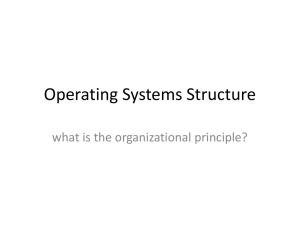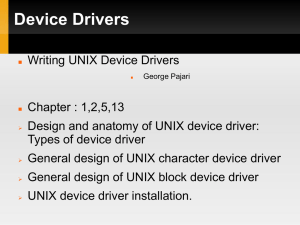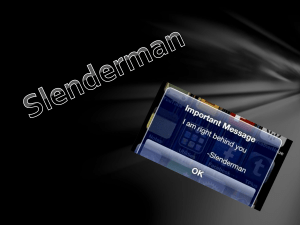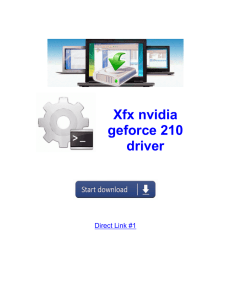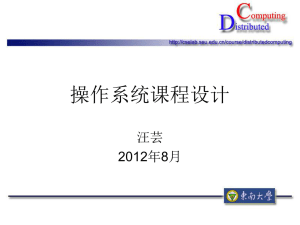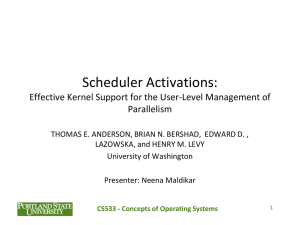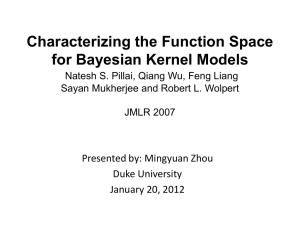Slide 0 - Better Embedded
advertisement
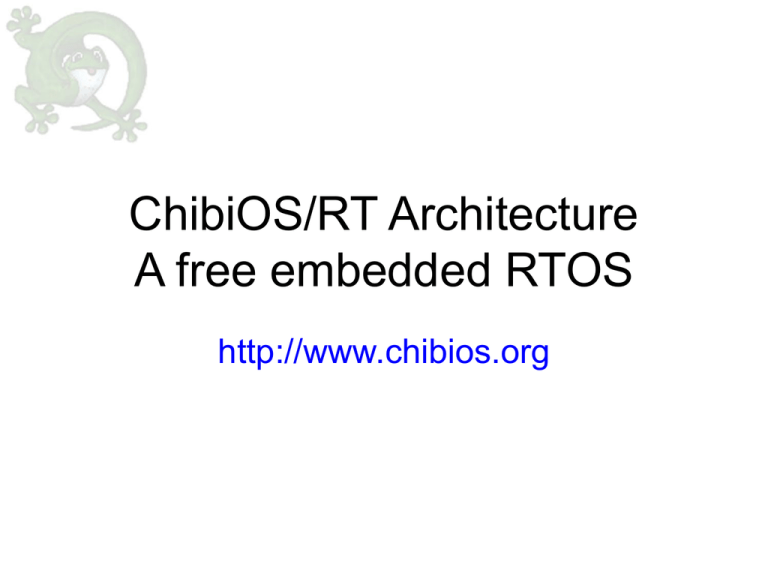
ChibiOS/RT Architecture
A free embedded RTOS
http://www.chibios.org
Design Concepts
• Static design
– Everything in the kernel is static, nowhere memory is allocated or freed
– Allocator subsystems are optionally available, built as a layer on top of the fully
static kernel
• No error conditions
– System APIs have no error conditions
– All the static core APIs always succeed if correct parameters are passed
• Simple, fast and compact
– Each API function should have the parameters you would expect
– Note, first “fast” then “compact”
• Portable
– Efficient layered architecture
– Non portable parts are small and enclosed in well defined layers
2
General Architecture
• Application
–
High level application code abstracted from
hardware details
• HAL
–
High level, cross platform, drivers API layer
• Kernel
–
Portable RTOS kernel layer
• Platform
–
Low level, platform-specific, drivers layer
• Port
–
Kernel port layer for a specific Architecture
• Board
–
Board-specific description and initialization code
• Hardware
–
The HW platform
3
Kernel Architecture #1
• System Interface module
– Initialization, ISRs abstraction, interrupts abstraction, context switching
• Basic Scheduler module
– Threads states transitions, scheduling strategy, centralized timeout management
• Threading module
– Threads creation, termination, delay, synchronization
• Virtual Timers module
– Unlimited Virtual Timers using a single physical timer used also for system tick
– System time handling
4
Kernel Architecture #2
• Semaphores
–
Both counter and binary variants supported
• Mailboxes
–
Thread to thread, ISR to thread, thread to ISR
• Mutexes and Condition Variables
–
–
Multilevel Priority Inheritance algorithm
Inspired by Posix mutexes mechanism
• Event Flags
–
Allow to wait for a single event or multiple events
• Messages
–
Fast context switch allows for efficient in-system client/server software architectures
• I/O Queues
–
Dedicated to communications between ISRs and Threads
• Abstract Streams Interface
5
Kernel Architecture #3
• Three optional Allocators
– Core Allocator (allocation only)
– Heap Allocator (classic alloc() and free())
– Pools Allocator (pools of fixed size objects)
• C-Runtime Allocator support
• Unified Memory Layout
– All allocators feed from the core allocator
• Dynamic Threading
– Support for dynamic threads creation and
termination
– Thread pools
6
Kernel Function Names
•
Function/macro names follow a rigid convention:
ch<SUB><NAME>[<CLASS>]()
•
•
•
•
ch denotes a kernel APIs
<SUB> is the kernel subsystem, for example Thd, Sem, Mtx etc
<NAME> is the function name, there are conventions about names to keep
the set consistent, for example:
–
“Init” denotes an object initialization function, the function can be used before the kernel is
initialized , for example chSemInit()
–
“Start<something>” starts and asynchronous activity that continues in background, for
example chThdStartStatic()
<CLASS> is the optional class that defines the API use context:
–
–
–
–
“none” is a normal function that has to be called from thread coontex
“S” is a function that must be called from within a critical zone and can reschedule internally
“I” is a function that must be called from within a critical zone and does not reschedule
internally
7
“FromIsr” is a function meant to be called from ISRs only
System States #1
• The system state defines which function classes can be called in a
given context
8
System States #2
• Some state transitions are always possible
• Fast IRQs can always preempt the kernel
• NMIs can always preempt anything
9
System States #3
•
•
•
•
•
“I-Class” APIs can be called in the S-Locked or I-Locked states only
“S-Class” APIs can be called in the S-Locked state only
Normal APIs can be called from the Normal state only
Initialization functions can be called in any context
NMIs and Fast Interrupts can use “delegate ISRs” in order to use
Kernel services
• The System State Checker debug option makes sure that the
functions are called in the correct context
10
Thread States
• Threads have several possible states
–
–
–
–
–
Suspended
Running
Ready
Sleeping
Terminated
11
Threads Life Cycle
• Static threads do not have a life cycle
• Dynamic threads must be handled
– Threads have one or more owners that can wait and recover memory, a
reference counter is part of the Thread structure
– Detached thread have no owners, memory can be recovered using the Registry
mechanism
12
Priority Inheritance
• ChibiOS/RT supports a “Multi Level Priority Inheritance” algorithm
–
–
–
–
The example is taken from the ChibiOS/RT test suite where there is a specific test case
testing this specific situation
Low priority thread 0 is the “resource holder”
Medium priority thread 1 is the thread preempting thread 0 with a CPU-intensive job
High priority thread 2 is the thread blocked by the lower priority thread 1, the Priority
Inheritance algorithm makes sure that thread 0 acquires temporarily the same priority of
thread 2 avoiding the condition of Priority Inversion
* Time ----> 0
10
20
30
40
50
60
70
80
90
100
*
0 ......AL++++++++++............2+++++++++++AU0---------------++++++G...
*
1 ..................++++++++++++------------------++++++++++++G.........
*
2 .............................AL..........++++++AUG...................
*
^
^
* Legend:
*
0..2 - Priority levels
*
+++ - Running
*
--- - Ready
*
... - Waiting or Terminated
*
xL
- Lock operation on mutex 'x'
*
xUn - Unlock operation on mutex 'x' with priority returning to level 'n'
*
G
- Goal
*
^
- Priority transition (boost or return).
13
ISR Abstraction
ISR are written in an architecture independent way, details are hidden
to the application developer
CH_IRQ_HANDLER(irq_vector_name) {
CH_IRQ_PROLOGUE();
/* IRQ handling code, preemptable if the architecture supports it.*/
chSysLockFromIsr();
/* Invocation of some I-Class system APIs, never preemptable.*/
chSysUnlockFromIsr();
/* More IRQ handling code, again preemptable.*/
CH_IRQ_EPILOGUE();
}
CH_FAST_IRQ_HANDLER(irq_vector_name) {
/* Fast IRQ handling code, preemptable if the architecture supports it.
The invocation of any API is forbidden here because fast interrupt
handlers can preempt the kernel even within its critical zones in
order to minimize latency.*/
}
14
Abstract Streams
• Abstract streams are an abstract interface for generic data streams
• They make the access to streams independent from the
implementation logic
• No code is present, streams are just abstract interfaces
• The stream interface can be used as base class for high level object
types such as files, sockets, serial ports, pipes etc.
• Inheritance and polymorphism made possible in C language using
virtual methods tables (VMTs) and wrapping macros:
#define chSequentialStreamWrite(ip, bp, n) ((ip)->vmt->write(ip, bp, n))
#define chSequentialStreamRead(ip, bp, n) ((ip)->vmt->read(ip, bp, n))
15
HAL Architecture #1
•
•
The HAL is responsible for MCU and
board initialization
The HAL offers abstract device
driver models
–
–
–
•
•
Device driver are designed to not be
MCU-specific, the API is generic
The platform layer implements the device
drivers for a specific MCU
MCU-specific details are restricted into
configuration structures that can be kept
separated from the application core
There are three distinct classes of
device driver
Device drivers are like classes that
inherit from a common ancestor
–
Common methods
16
Board Files
• Boards are described by just three simple files
– Boards are easily added by creating 3 new files (board.h, board.c, board.mk)
• board.c , board-specific initialization code
• board.h, board clock settings, board I/O settings, on board PHY name
• board.mk, board makefile segment, very small
– A graphical configurator exists
• Applications can be switched to other boards
– Just change the board name in the Makefile to retarget your application
– I/O pin names can be different
– Differences can be “encapsulated”
17
Device Driver Classes
• Platform Device Drivers
– Device drivers that are specific of a platform and have a non-standard API
– Usually helpers for other driver, for example a centralized DMA manager
• Normal Device Drivers
– Split in a portable High Level Driver (HLD) and a platform-specific Low Level
Driver (LLD)
– Implement a generic functionality on a specific platform
• Complex Device Drivers
– Drivers that are completely portable, they use other device drivers in order to
communicate with hardware, for example the MMC driver uses a SPI driver as
interface, the USB-CDC driver uses a USB driver
– Implement a generic functionality on any platform
18
Device Drivers are State Machines
Device Drivers are described using state diagrams
API usage context and
callbacks triggering are
clearly described
19
Device Drivers #1
• ADC
– Able to work in “streaming” mode where a buffer is continuously filled with
samples from one or more channels
– Supports DMA transfers
– Able to generate callbacks at half/full buffer marks
• CAN
– Allows to exchange frames among CAN devices
• EXT
– Generates callbacks on input pins state transitions
• GPT
– Periodic or one-shot callbacks generated by an hardware timer
– Delays
20
Device Drivers #2
• I2C
– Can support DMA transfers
• ICU
– Input Capture Unit
– PWM Input
– Measures Periods and Pulse Width
• PWM
– Dynamically variable period and duty cycle
– Can call callbacks on pulse end and on cycle end
• MAC
– Ethernet driver supporting uIP and lwIP stacks
21
Device Drivers #3
• PAL
– Ports Abstraction Layer, abstracts digital I/O
– Pins reconfiguration at board initialization and at runtime
– Handles Pins, Ports or Pin Groups
• RTC
– Clock Calendar with wakeup capability
• SDC
– SD/MMC interface via SDIO
• MMC_SPI
– SD/MMC interface via SPI
• SPI
– Supports DMA transfers
– Synchronous or Asynchronous API with callback capability
22
Device Drivers #4
• Serial
– Serial UART driver with circular buffers
– Able to generate kernel events on I/O events
• Serial over USB
– Implements a CDC class USB device
– Same software interface of a normal Serial driver, interchangeable
• UART
– Asynchronous UART driver
– Packets oriented
– Supports DMA transfers with callbacks
• USB
– USB device abstraction
– Callbacks capable
23
Time Measurement Unit
• Cycle-accurate time measurement
• Repeated measurements
– Able to report worst-best-last measurements
• Cycle-accurate delays
• Utility macros to convert among time units
– Cycles to microseconds, microseconds to cycles
– Cycles to milliseconds, milliseconds to cycles
– Cycles to seconds, seconds to cycles
• Requires a dedicated hardware free running counter
24
Application Organization
•
The standard application template
– main.c, application main
– chconf.h, kernel configuration file
•
•
Kernel options
Kernel hooks
– halconf.h, HAL configuration file
•
Include/exclude the various device drivers
– mcuconf.h, MCU configuration file
•
•
•
•
Setting up the various peripherals parameters
IRQ priority
DMA priority
Any other HW-related setting
– Makefile, build file
•
•
•
All files are available as templates
Settings defaults are almost always acceptable
Always the same, learn once use anywhere
25
End of Architecture
26

